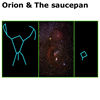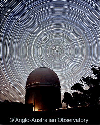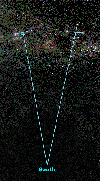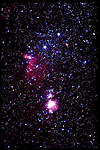 Constellations are visible groups of stars that appear as patterns
in the sky. The Southern Cross and Orion are constellations. Different
cultures have different names and see different patterns in the same sets
of stars. For example, Orion "The Hunter" is also known as "The
Turtle" to the Thai people.
Constellations are visible groups of stars that appear as patterns
in the sky. The Southern Cross and Orion are constellations. Different
cultures have different names and see different patterns in the same sets
of stars. For example, Orion "The Hunter" is also known as "The
Turtle" to the Thai people.
 Astronomically, constellations are not real groups of stars like
galaxies. Constellations do have an important role to play as guides or
references in the night sky. The stars in the Southern Cross and pointers
display this well; they are important as direction finders in the Southern
Hemisphere. The stars themselves range in distance from Earth to Alpha
Centauri at 4.3 light years to Delta Crucis at 590 light years.
Astronomically, constellations are not real groups of stars like
galaxies. Constellations do have an important role to play as guides or
references in the night sky. The stars in the Southern Cross and pointers
display this well; they are important as direction finders in the Southern
Hemisphere. The stars themselves range in distance from Earth to Alpha
Centauri at 4.3 light years to Delta Crucis at 590 light years.

|
Relative distances - stars |
The history of constellations
From the earliest times, constellations, parts of constellations (known
as asterisms), and individual stars have received names depicting meteorological
phenomena or religious and mythological beliefs. Constellation names are
steeped in history, with many coming from the ancient Greeks. Forty eight
constellations were named in ancient times, with another 40 constellations
added by European astronomers in the 17th and 18th centuries.
 In the 20th century, the sky or celestial globe was divided up into
88 constellations with precise boundaries by the International Astronomical
Union. By 1930, all stars had been assigned to a constellation. This aided
in easier identification and positioning of stars in the sky, but says
nothing about their nature or true place in space, only their direction
from Earth.
In the 20th century, the sky or celestial globe was divided up into
88 constellations with precise boundaries by the International Astronomical
Union. By 1930, all stars had been assigned to a constellation. This aided
in easier identification and positioning of stars in the sky, but says
nothing about their nature or true place in space, only their direction
from Earth.
Viewing southern constellations
On a clear, dark night, the southern night sky is spectacular - especially
in winter, when we have the best possible view of the Milky Way.
 The most well known of the Southern Hemisphere constellations is
Crux Australis, better known as the Southern Cross. Its long axis is,
by chance, directed to the point in the sky called the South Celestial
Pole, which is exactly above the southern horizon. It is so far south
that its stars were not well known by ancient Northern Hemisphere astronomers.
The first references to it as having the shape of a Cross seem to come
from Andrea Corsali, the Italian explorer, in 1517.
The most well known of the Southern Hemisphere constellations is
Crux Australis, better known as the Southern Cross. Its long axis is,
by chance, directed to the point in the sky called the South Celestial
Pole, which is exactly above the southern horizon. It is so far south
that its stars were not well known by ancient Northern Hemisphere astronomers.
The first references to it as having the shape of a Cross seem to come
from Andrea Corsali, the Italian explorer, in 1517.
 The next most well known is probably Orion, a giant hunter from Greek
Mythology. The stars do indeed appear to have the shape of a man wielding
a club and having a sword attached to his belt. It is the stars of the
belt that make Orion easy to spot - the belt is formed by three bright
stars in a nearly straight line.
The next most well known is probably Orion, a giant hunter from Greek
Mythology. The stars do indeed appear to have the shape of a man wielding
a club and having a sword attached to his belt. It is the stars of the
belt that make Orion easy to spot - the belt is formed by three bright
stars in a nearly straight line.
The Southern Cross, Orion, and other southern constellations are shown on the star map.
| Copyright owned by the State of Victoria (Department of Education and Early Childhood Development). Used with Permission. |